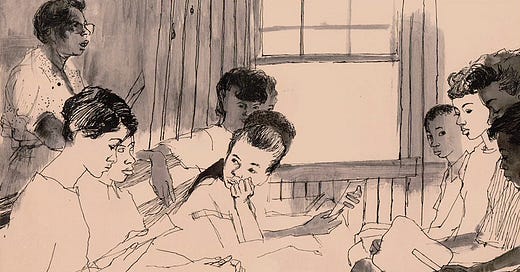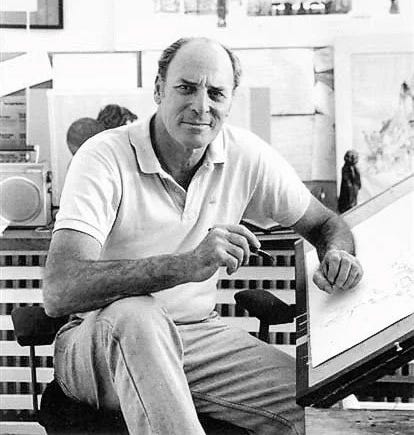Tracy Sugarman: Insights from Freedom Summer
Drawing Hatred and Hope in 'Jim Crow' South

Illustrator Tracy Sugarman (1921 - 2013) would talk about the two extraordinary ‘invasions’ that shaped him as a person and set his path as an artist. One being his participation in the amphibious force that stormed the Normandy beachhead on D-Day, 1944. The other being part of Freedom Summer in 1964, the campaign of volunteers, teachers and organizers that challenged America's apartheid in Mississippi.
During his War service, Sugarman mailed watercolors, pen-and-ink drawings and love letters back to his new wife. This was the reportage of a young man illustrating the terror and tedium of battle; and the feelings, ideals and hopes he wanted to share. These drawings were eventually published in My War: A Love Story in Letters and Drawings.
“I spent months on that battered Normandy beachhead with the men in my charge. It was there that I discovered that through drawings and the writing I was sending to my new wife, I could come to understand and rationalize the tragic world I was in.”
In 1964, he left his Connecticut home to join student volunteers heading south, to spend ten weeks in Ruleville, in the heart of the Mississippi Delta, attempting to register as many African-American voters as possible; and teaching adults and children to read in Freedom schools. He made dozens of evocative drawings of what he saw and experienced.






The Freedom Summer project was designed to draw the nation's attention to the violent oppression experienced by Mississippi blacks who attempted to vote. These volunteers faced many challenges, including threats of violence. The Klu Klux Klan and racist Southerners were ever-present to inhibit them. For Sugarman, the challenge was in how to best draw the moments of heroism of black Americans.
“It takes more than agility and the capacity to draw rapidly. It demands an honesty of purpose, relating to your subject that is less technical than human. If the moment is worth preserving, then I have the responsibility of trying to endow the drawing with the compassion that comes from understanding. It is only in this fragile dimension that the artist's gift to the viewer can be made.”
Three CORE workers: James Chaney, Michael Schwerner and Andrew Goodman were killed by the Klan. It drew national attention because two were white, which had been overlooked many other victims of racial violence.
Tracy Sugarman was changed by the experiences in Mississippi. While he returned to his career as a commercial illustrator, taking commissions for books and record covers, he remained a committed visual journalist, covering stories as the appalling conditions in Rikers Island jail for the New York Times and the Malcolm X trial for the Saturday Evening Post.
“I become part of the picture emotionally, and I often find myself having to reexamine assumptions and generalizations I held before being exposed to the real thing. It's a revelatory experience, one that invariably challenges my preconceived ideas. I feel fortunate in having the chance to touch life in a manner that few people have the opportunity to do. The experiences I've had, the pleasures I've derived, and the feeling of sometimes being able to make a contribution of value through my work continues to sustain me. Working only in my studio may increase my knowledge of materials, of technique, but not of the world. When I'm on-site, I meet people. We talk and trade ideas and opinions. I learn about them, and sometimes more about myself then I suspected.”

Freedom Summer was a grassroots movement that brought optimism to a difficult issue in America. It’s often given credit for its role in what became The Voting Rights Act of 1965. It was an important step in the civil rights movement. It spurred on the student activism that would follow throughout the 1960’s. One can only hope that this idealism is sustainable.
Tracy Sugarman played a part in it through his drawing and reporting. We realize how ink and pencil can record an event and leave a legacy of graphic potency.
*The quotes above are taken from Drawing Conclusions: An Artist Discovers His America, Syracuse University Press, 2007
More to Know:
Tracy Sugarman wrote two books on his experiences as a Freedom Summer volunteer: Stranger at the Gates: A Summer in Mississippi, Easton Studio Press, LLC, 1966; and We Had Sneakers, They Had Guns, University Press, 2007.
Tracy Sugarman writes thoughtful reflections about his life, art and what it means to be an American in Drawing Conclusions: An Artist Discovers His America, Syracuse University Press, 2007.
Sugarman made drawings based on his photographs that were featured in the PBS documentary Freedom Summer, which can be viewed here.
Operation Meatball takes oral histories of war veterans, including some of Sugarman's war stories.







Fascinating, thank you Bill. I’ve just ordered the war recollections book. (That’s the second book I’ve ordered off the back of this newsletter! Happily I can pick then up secondhand.) My grandfather was in charge of one of the amphibious vehicles that landed in Normandy that day. He didn’t like to talk about his war experiences. It’s going to be insightful reading Sugarman’s account. I’ll take the book with me next time I visit my parents. I was also grateful to have learnt about the Freedom Summer project.
These illustrations are sublime.